Dinosaur Fundamentals
In dissecting the prehistoric universe of giants, one must understand the categorizations and characteristics that define the true essence of dinosaurs.
This deep dive into the fundamentals breaks down what constitutes a dinosaur, differentiates two major classifications, and sketches the canvas of their existence: the Mesozoic Era.
Defining ‘Dinosauria’
The term ‘Dinosauria’ refers to a diverse group of reptiles first recognized and named by Sir Richard Owen in 1842.
Characterized by an upright stance, a predominantly gigantic size, and an array of adaptive features, dinosaurs exhibit a majestic blueprint distinct from other prehistoric species.
They are not your garden-variety lizards but a separate clade altogether. ‘Dinosauria’ envelops an exclusive membership of land-roaming reptiles that walked the Earth between 230 to 66 million years ago.
Dinosaur Kingdom: Saurischia vs Ornithischia
Saurischia and Ornithischia stand as the twin pillars of the dinosaur kingdom.
However, their skeletal structures splinter this unity.
- Saurischia, or lizard-hipped dinosaurs, boast a pelvic structure akin to that of modern lizards.
This group further branches into carnivorous theropods, including the fierce Tyrannosaurus rex, and the long-necked herbivorous sauropodomorphs.
- Ornithischia, the bird-hipped dinosaurs, showcase a pelvic configuration resembling that of birds.
Members of this group are all herbivores, with species ranging from the armored Stegosaurus to the crested Parasaurolophus.
Each of these divisions reflects evolutionary pathways that have stoked endless scholarly debates and fascination.
Reconstructing The Mesozoic Era
The Mesozoic Era, Earth’s middle age, is the grand stage where dinosaurs reigned supreme for approximately 186 million years.
Divided into Triassic, Jurassic, and Cretaceous periods, this era is marked by the rise and fall of myriad dinosaur species.
Palaeontologists piece together fossils and geological evidence to rebuild this bygone world, profiling the dominance of these magnificent reptiles.
It’s an epic span of time, densely populated with a variety of dinosaur species that carved their legacy into the very rocks of our planet.
Physical Attributes of Dinosaurs
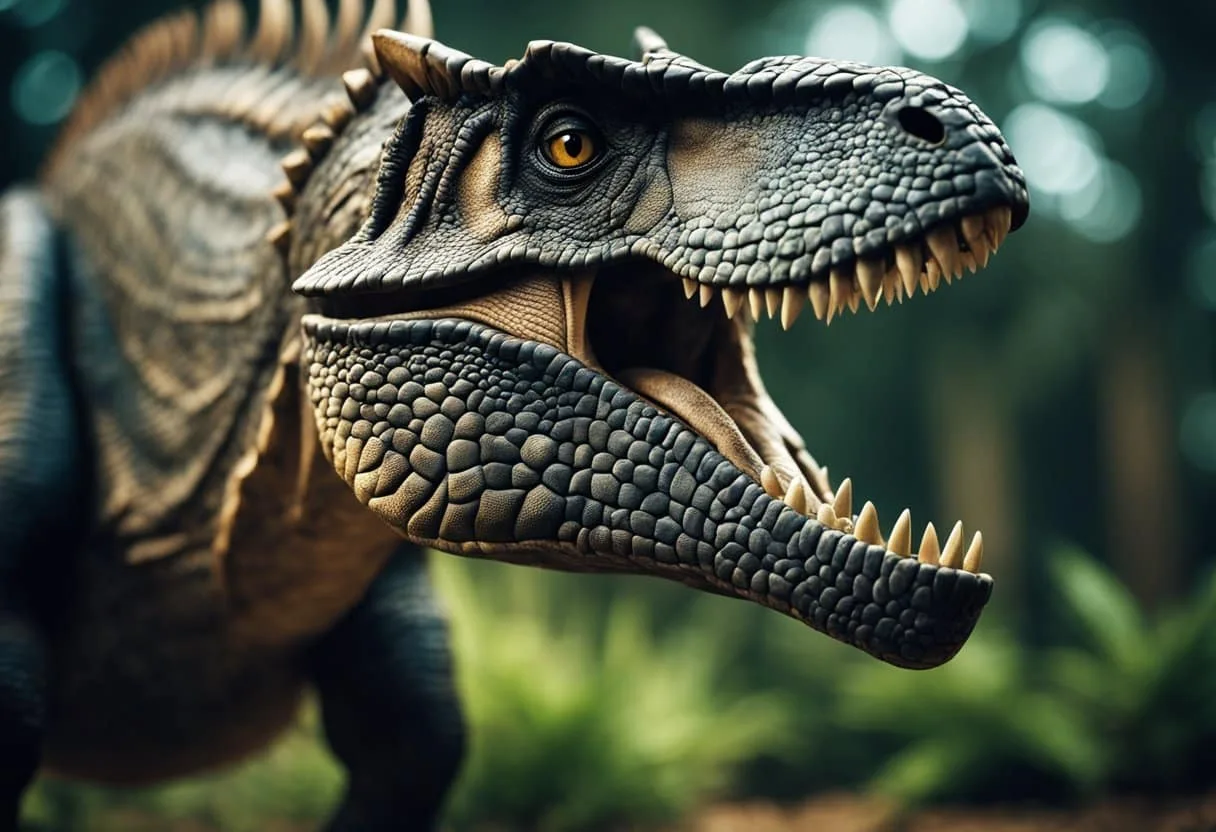
Dinosaurs were a spectacular group of animals with a variety of physical characteristics that adapted them for their respective environments and lifestyles.
From the iconic long necks of sauropods to the sharp teeth of theropods, their features paint a picture of diversity and evolutionary wonder.
Majestic Necks and Mighty Legs
Sauropods laid claim to some of the longest necks in the animal kingdom, a design that allowed them to reach high vegetation and established their dominance as land-based herbivores.
Moreover, dinosaurs displayed an impressive range of leg configurations, with many bipedal species having strong back legs for running and maneuvering, while quadrupeds boasted large, columnar legs providing support for their massive bodies.
The hips of dinosaurs were critical in this regard, with designs differing between the bird-hipped (ornithischians) and lizard-hipped (saurischians) forms, a distinction that continues to intrigue paleontologists.
The Mystery of Dinosaur Skin
While dinosaur skin doesn’t readily fossilize, what scientists have unearthed reveals a variety of textures, from the armored plates of ankylosaurs to potential evidence of feathers in theropods like Velociraptor.
Analysis of fossilized skin imprints suggests the existence of scales in many species, giving clues to their protective measures and thermoregulation.
Thanks to research on specimens such as those from the origin and early radiation of dinosaurs, the conversation about dinosaur skin continues to evolve.
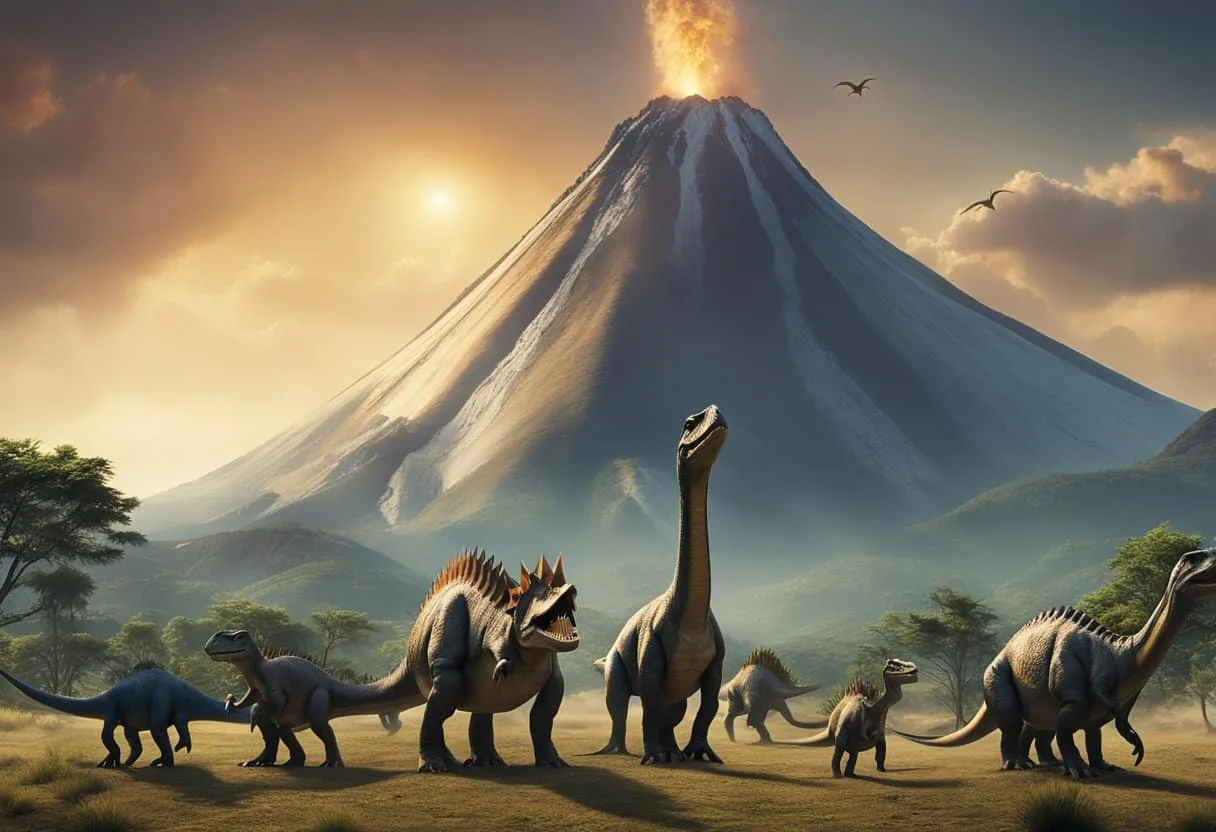
Dinosaur Dental Records
Pivotal to understanding dinosaur diets are their teeth – the serrated blades of carnivores like Tyrannosaurus exhibit wear patterns that speak to their bone-crushing bites.
On the other end of the diet spectrum, the flat, grinding teeth of hadrosaurs suggest a life spent munching on tough vegetation.
One can’t overlook their jaws, engineered to complement their dietary habits, whether it was to rip flesh or crush plant material.
The massive head structures of some dinosaurs, adorned with unique claws and formidable teeth, exemplify nature’s raw creativity.
The Dinosaur Lifestyle
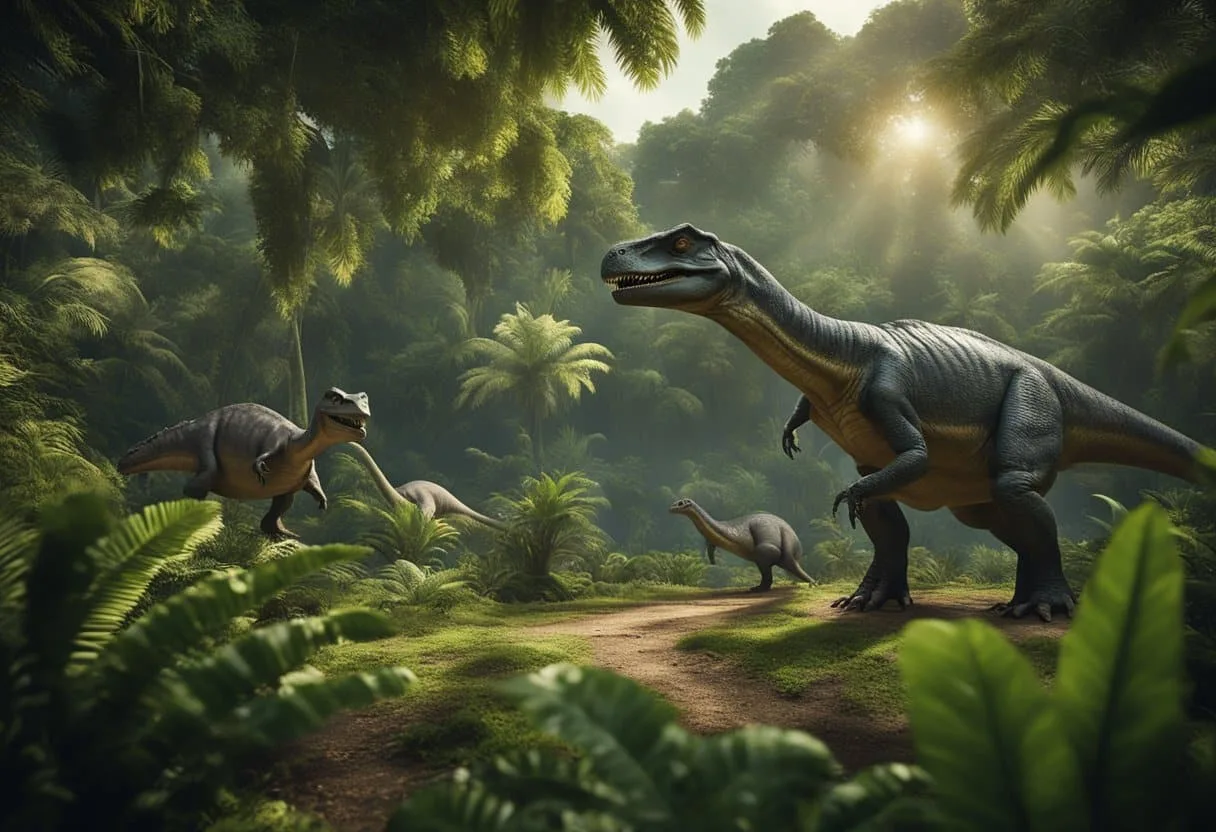
Dinosaurs dominated prehistoric Earth with an array of lifestyles as diverse as their formidable anatomies.
The distinction in dietary habits between carnivorous and herbivorous species was stark and shaped their respective daily routines, social structures, and physical adaptations.
Daily Life on Prehistoric Earth
The daily existence of dinosaurs varied wildly from species to species.
Herbivores, those plant-eaters of the Mesozoic era, spent their days grazing on the abundant vegetation, ranging from ferns to towering conifers.
They often moved in herds, which provided some defense against predators.
Dinosaurs like the Stegosaurus, with plates and spikes, relied on their armor for protection as they nibbled on low-lying shrubs.
On the other end of the spectrum, bipedal theropods, such as the iconic Tyrannosaurus rex, led a more solitary life, honing their hunting skills to catch prey.
Carnivores vs. Herbivores: A Dietary Divide
The dietary divide between carnivorous and herbivorous dinosaurs is a tale of evolution’s arms race.
The carnivores, equipped with sharp teeth and claws, were the meat-eating machines of their time.
Their lives revolved around the pursuit and capture of food, which included other dinosaurs.
Anatomical features like strong hind limbs and acute senses made them formidable predators.
Conversely, the herbivores were often built like fortresses.
Many species such as the Ankylosaurus, with armor plating and clubs for tails, were built to survive in a world of giants.
These plant eaters also showed a diverse range of adaptations to their diets: Triceratops had strong beaks and teeth arranged in a battery, perfect for shearing tough vegetation like leaves and cycads.
Bird-like dinosaurs, some believe to be direct ancestors of today’s birds, displayed varied lifestyles too.
While all dinosaurs laid eggs, these creatures might have shown early signs of complex behaviors related to nesting and caring for their young, not unlike modern birds.
Despite their differences, both carnivores and herbivores had to navigate a world that was changing and challenging, ensuring the dinosaur’s reign for over 160 million years.
Living on a dynamic Earth, their lifestyles tell a story of adaptation, survival, and ultimately, a legacy that has captivated humanity’s imagination for generations.
Iconic Dinosaurs and Their Traits

Dinosaurs have captivated the imagination for generations, and certain species stand out for their defining characteristics and awe-inspiring presence.
Let’s explore some of the most remarkable dinosaurs and the traits that have made them the stars of the prehistoric world.
Meet the Star Players: T-Rex and More
Tyrannosaurus rex, also known as the king of the tyrant lizards, reigned supreme with its massive skull, powerful jaw, and teeth engineered for slicing through flesh.
This bipedal carnivore, a member of the theropods, has become a symbol of prehistoric might, with fossils discovered throughout North America rightly positioning it as the apex predator of its time.
Spinosaurus easily stands out with its distinctive sail-like structure on its back, which could reach a height of up to 2 meters.
It is considered one of the largest carnivorous dinosaurs, potentially even surpassing the T-Rex in size.
Adapted for an aquatic lifestyle, it possibly hunted its prey in water, an unusual behavior among known theropods.
The Triceratops, a herbivorous ceratopsid, sported three formidable horns on its face and a large bony frill that could have been used in defense or display.
Roaming the Late Cretaceous landscapes, it was one of the last standing dinosaur species before the mass extinction.
Stegosaurus boasted a row of large, flat bony plates along its back and a spiked tail, thought to serve as a deterrent for predators.
Its small head and brain, in proportion to its body, have sparked endless discussion about its lifestyle and capabilities.
Gentle Giants: The Life of Sauropods
The sauropods, truly the gentle giants of the Mesozoic era, represented the largest animals ever to walk the Earth.
With their enormously long necks and tails, they have become synonymous with the term “dinosaur.” Diplodocus and Apatosaurus, for instance, were distinguished by their whip-like tails and peg-like teeth designed for stripping vegetation.
Brachiosaurus, another sauropod, stood out from its relatives with longer forelimbs than hindlimbs, giving it an almost giraffe-like stance, allowing it to reach higher vegetation.
Its nasal openings on the top of its head have led some to speculate that it possessed a good sense of smell.
The Euoplocephalus, meanwhile, although not a sauropod, deserves a mention for its impressive defensive adaptations, such as the bony club at the end of its tail and armored plates covering its body.
This ankylosaur was a fortress on legs, ready to swing its tail club at any would-be threats.
Dinosaurs like these have painted a vivid picture of the past, each with unique traits that have helped paleontologists reconstruct their way of life and dominance over ancient ecosystems.
While the earth no longer shakes under the feet of these giants, their legends continue to inspire and educate.
Discovering the Dinosaurs
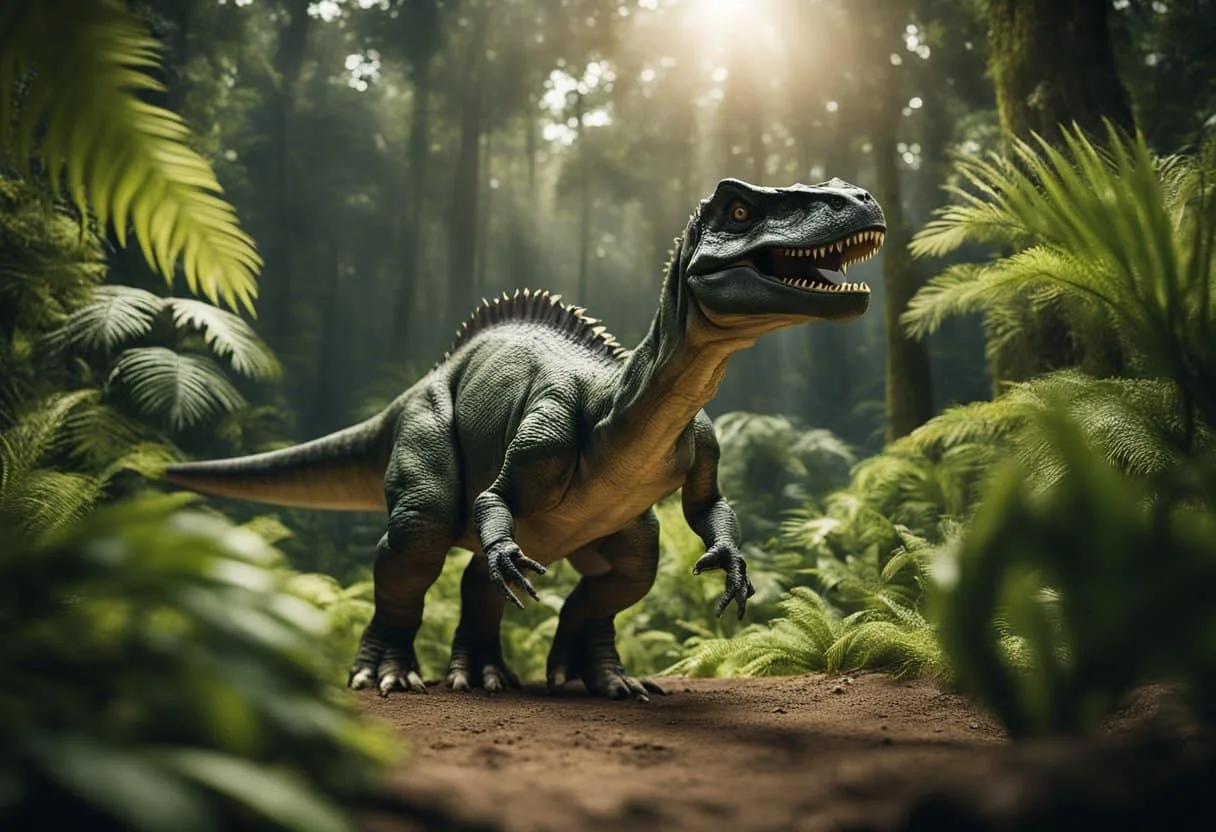
Uncovering the mystery of dinosaurs involves the meticulous analysis of ancient traces left behind.
Mainly, these traces come in the form of fossils, which provide a keyhole view into the era when these titanic creatures roamed the Earth.
This section delves into how the giants of the prehistoric world were unearthed and the scientific domain that has dedicated itself to the study of such magnificent beasts.
Unearthing the Giant Reptiles
The journey into the world of dinosaur fossils began in earnest in the 19th century when the first scientifically recognized dinosaur, Megalosaurus, was described.
Following close behind was Iguanodon, another early find that confirmed these creatures were not solitary anomalies.
Both discoveries shattered previous misconceptions, painting a picture of an Earth where enormous reptiles once dominated.
Richard Owen, a pioneering figure in paleontology, christened these creatures “dinosaurs,” meaning “terrible lizards,” which firmly established the group in scientific circles.
It’s not just the bones that tell the tale; footprints preserved in sedimentary rock open chapters in the story, revealing the behavior and locomotion of these prehistoric reptiles.
Each trace fossil offers a snapshot, a single frame in the grand cinema of dinosaurian life.
To unearth these clues, one must often venture into the badlands, where erosion carves into the layers of the Earth’s crust, exposing the secretive appendages of a world long gone.
The Role of Paleontology
The discipline of paleontology scissors through the ages, reconstructing life from fragments.
This branch of earth science meticulously pieces together the remnants found in various geological contexts to illuminate the life and times of extinct species.
Paleontologists must be detectives of deep time, extracting every nugget of data from sedimentary rock, the storied pages where most dinosaur remains are found.
Plateosaurus, an early long-necked dinosaur, exemplifies how paleontological methods have evolved to understand dinosaur biology and evolution.
Sites rich in Plateosaurus remains, for instance, provide extensive evidence of herd behavior and growth patterns.
Using techniques like comparative anatomy and cladistics, paleontologists can interpret the evolutionary relationships among dinosaurs, effectively fleshing out the family tree of these ancient organisms.
Dedicated dinosaur hunters have traveled the globe, from the rocky deserts of North America to the Gobi Desert and beyond, in pursuit of these prehistoric puzzles.
Each new discovery, whether it’s a tiny femur or a grand skull, adds an essential piece to the ever-involving narrative of life on Earth.
The work done by these adventurers of science enables humanity to understand the depths of time and the creatures that came before us, shaping our perception of natural history.
The Great Dinosaur Extinction
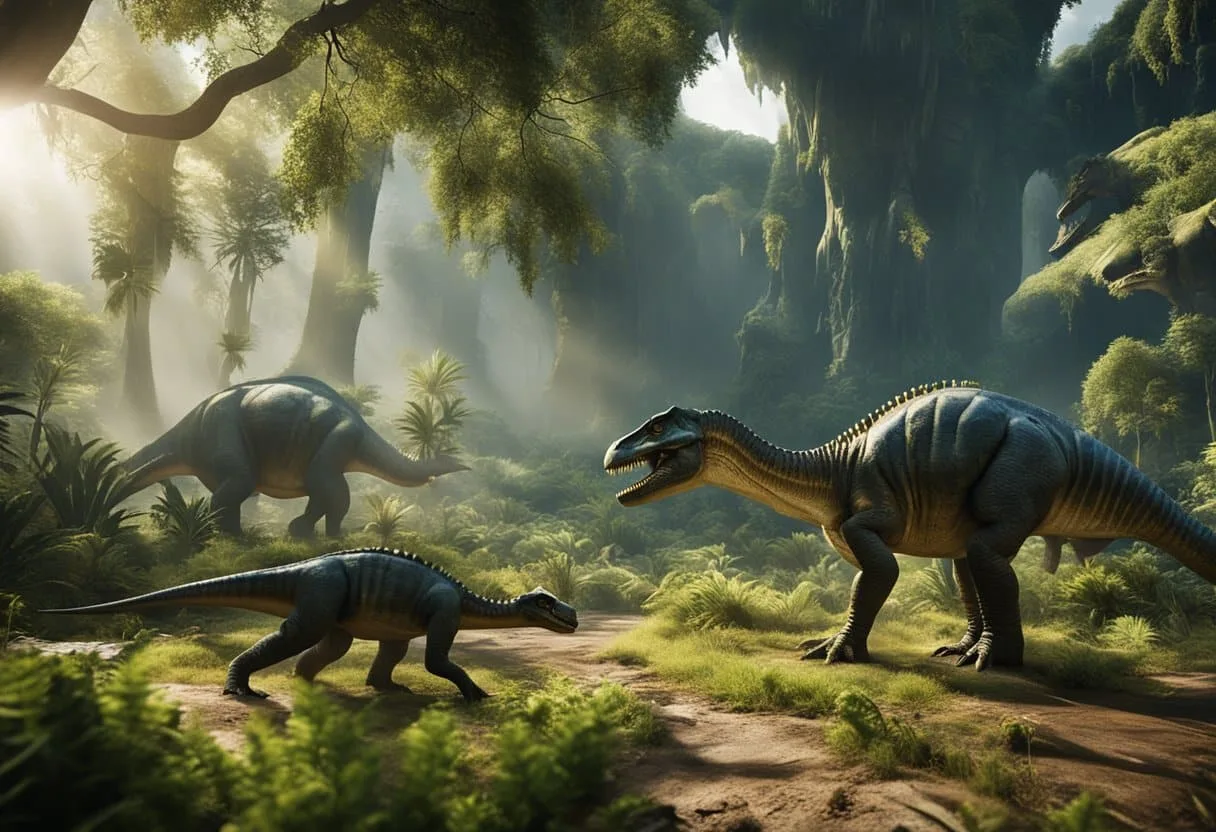
The demise of the dinosaurs marks one of Earth’s most dramatic mass extinctions.
Fossils tell the tale of a once-thriving Age of Reptiles abruptly ended by an event that reshaped the very fabric of life on our planet.
End of an Era: The Cretaceous Catastrophe
The close of the Cretaceous Period brought about the sudden and catastrophic end to the reign of the dinosaurs.
It is a firmly established fact that these colossal creatures, who had dominated the Earth’s ecosystems for over 150 million years, were wiped out in a geological blink of an eye.
The fossil record exhibits a sharp decline in dinosaur remains post the infamous K-T boundary, indicating a rapid and fatal collapse (see The extinction of the dinosaurs).
Unveiling Extinction Theories
When delving into the theories surrounding this mass extinction, two viewpoints persist as the most compelling.
Firstly, evidence supports the likelihood of a cataclysmic asteroid impact, creating a worldwide soot-filled atmosphere that led to a prolonged “nuclear winter” effect.
Secondly, there has been a great deal of discussion around the possibility of massive volcanic activity, specifically the Deccan Traps eruptions, which would’ve spewed forth enough ash and toxic gases to trigger a prolonged climate change.
The reality is likely a combination of both, creating a one-two punch that ensured the dinosaurs’ fate (see The “Great Extinction” that never happened: the demise of the dinosaurs considered).
Each theory holds its own weight, and yet, one might argue that it takes more than a single disaster to erase such a diverse and widespread group as the non-avian dinosaurs.
Thus, some scientists suggest a series of catastrophic events, each compounding upon the last, ultimately culminating in a full-blown extinction.
Dinosaurs’ Living Legacy
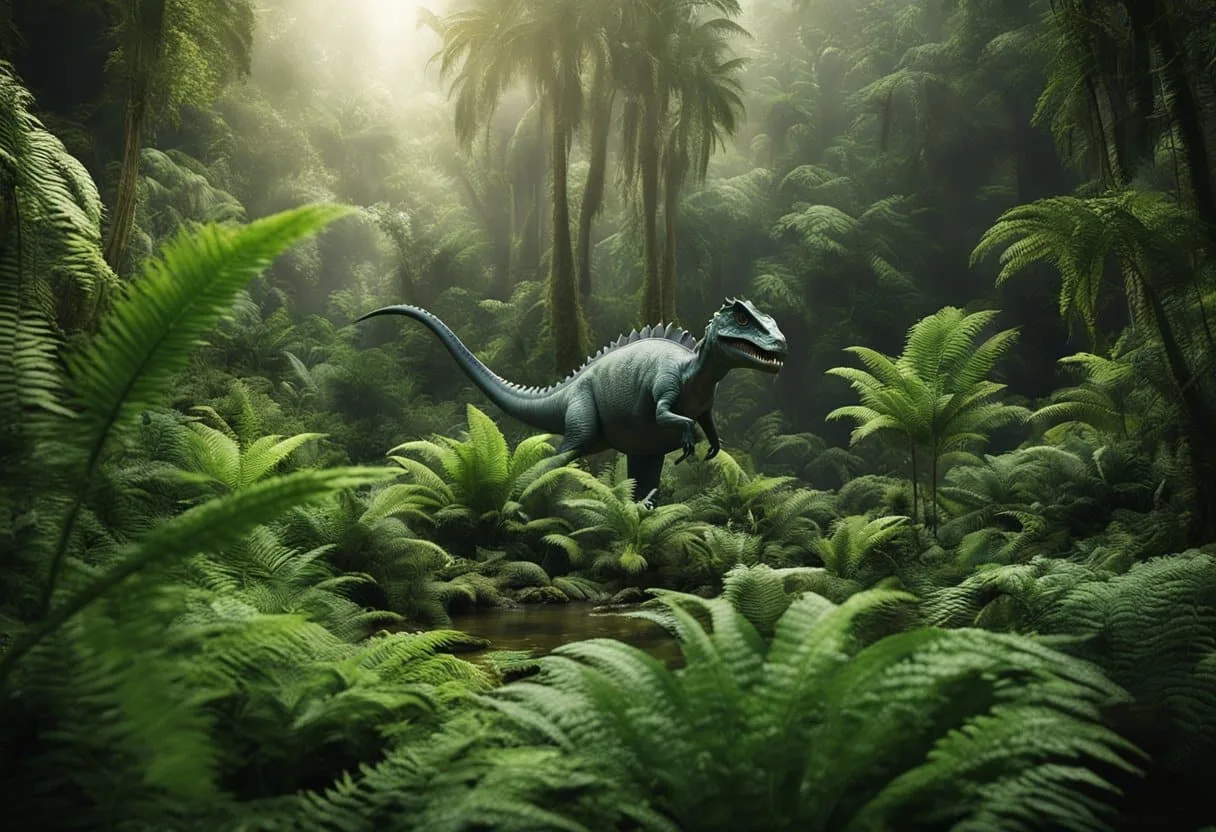
In examining the enduring impact of dinosaurs, it’s clear that their long-ago departure from the planet’s stage left a void now filled with fascinating research and remnants visible in modern animals.
One can’t overlook how elements of their biology continue to impact our scientific understanding and day-to-day life.
From Scales to Feathers: The Avian Connection
The notion that birds are modern-day dinosaurs isn’t just whimsy; it’s scientific fact backed by comprehensive genetic and anatomical evidence.
The avian dinosaur lineage evolved into these feathery beings that dominate our skies today.
Chickens, as mundane as they may seem, strut their dinosaur heritage with every cluck and peck.
Biologically, they are the theropod dinosaurs’ most ubiquitous living ambassadors, displaying traits like scaled legs reminiscent of their ancient predecessors.
Dinosaurs in Today’s Ecosystem
Contrary to the common belief that dinosaurs have no place in today’s world, their legacy is deeply intertwined with our ecosystems.
The study of their fossils has not only revolutionized paleontology but has also provided key insights into contemporary conservation efforts.
One doesn’t simply look at an elephant and acknowledge its enormity without subconsciously juxtaposing it with the grandeur of the dinosaurs, reinforcing their role as a measure for today’s megafauna.
Their existence, research shows, is a display window into ancient ecologies that inform current environmental strategies.
Debunking Dinosaur Myths
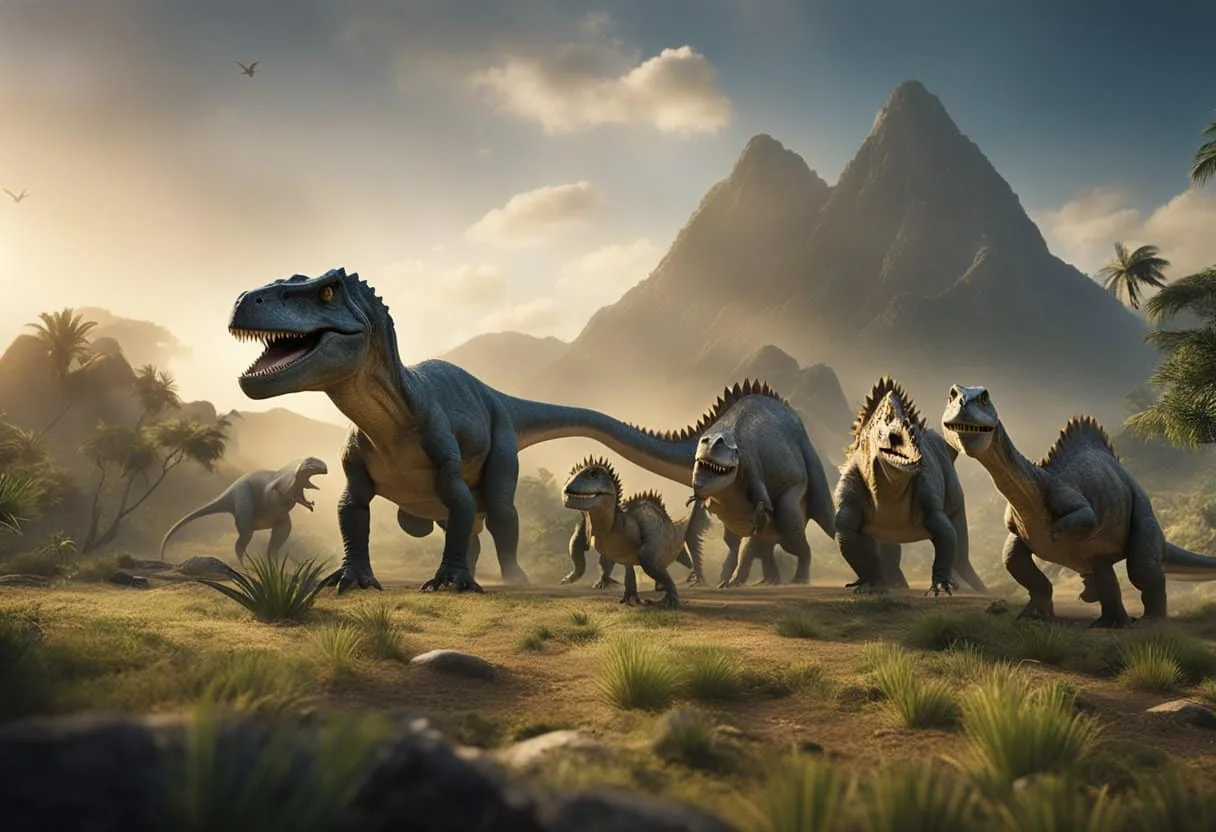
Before diving into the common misconceptions, it’s crucial to understand that dinosaurs are a diverse group of animals with varying characteristics that often get oversimplified or misinterpreted in popular media.
Separating Facts from Fiction
Myth: Dinosaurs were giant lizards.
Fiction: The portrayal of dinosaurs as merely oversized lizards is as outdated as a rotary phone.
Dinosaurs belonged to their own distinct groups and were often more bird-like than reptilian.
Myth: All dinosaurs lived at the same time.
Fiction: This misconception flattens the Mesozoic Era into a single snapshot.
In reality, different species of dinosaurs roamed the Earth across multiple periods, from the Triassic to the Cretaceous, over 180 million years.
Myth: Dinosaurs were always colossal.
Fiction: Size varies dramatically across dinosaur groups.
While some like the towering Argentinosaurus stretched over 100 feet, others like the chicken-sized Microraptor were smaller than a human child.
Myth: Dinosaurs were cold-blooded killers.
Fiction: Recent studies suggest some dinosaurs regulated their body temperature in a manner similar to modern birds, rather than the slow metabolism associated with cold-blooded lizards.
Myth: Dinosaurs are extinct.
Fiction: Birds are essentially living dinosaurs, having evolved from theropods.
This means that when one sees a sparrow, they’re essentially looking at a distant dinosaur descendant.
By tackling these myths head-on, one can appreciate the diversity and complexity of dinosaur life, and in doing so, honor the true legacy of these remarkable creatures.

